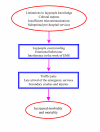Post-crash management of road traffic injury victims in Iran. Stakeholders' views on current barriers and potential facilitators
- PMID: 19435521
- PMCID: PMC2692975
- DOI: 10.1186/1471-227X-9-8
Post-crash management of road traffic injury victims in Iran. Stakeholders' views on current barriers and potential facilitators
Abstract
Background: Road traffic injuries are a major public health problem, especially in low- and middle-income countries. Post-crash management can play a significant role in minimizing crash consequences and saving lives. Iran has one of the highest mortality rates from road traffic injuries in the world. The present study attempts to fill the knowledge gap and explores stakeholders' perceptions of barriers to - and facilitators of - effective post-crash management in Iranian regions.
Methods: Thirty-six semi-structured interviews were conducted with medical services personnel, police officers, members of Red Crescent, firefighters, public-health professionals, road administrators; some road users and traffic injury victims. A qualitative approach using grounded theory method was employed to analyze the material gathered.
Results: The core variable was identified as "poor quality of post crash management". Barriers to effective post-crash management were identified as: involvement of laypeople; lack of coordination; inadequate pre-hospital services; shortcomings in infrastructure. Suggestions for laypeople included: 1) a public education campaign in first aid, the role of the emergency services, cooperation of the public at the crash site, and 2) target-group training for professional drivers, police officers and volunteers involved at the crash scene. An integrated trauma system and infrastructure improvement also is crucial to be considered for effective post-crash management.
Conclusion: To sum up, it seems that the involvement of laypeople could be a key factor in making post-crash management more effective. But system improvements are also crucial, including the integration of the trauma system and its development in terms of human resources (staffing and training) and physical resources as well as the infrastructure development.
Figures
Similar articles
-
The requirements and challenges in preventing of road traffic injury in Iran. A qualitative study.BMC Public Health. 2009 Dec 23;9:486. doi: 10.1186/1471-2458-9-486. BMC Public Health. 2009. PMID: 20030826 Free PMC article.
-
Traffic police officers' experience of post-crash care to road traffic injury victims: a qualitative study in Tanzania".BMC Emerg Med. 2019 Oct 11;19(1):51. doi: 10.1186/s12873-019-0274-x. BMC Emerg Med. 2019. PMID: 31601171 Free PMC article.
-
Barriers and facilitators to provide effective pre-hospital trauma care for road traffic injury victims in Iran: a grounded theory approach.BMC Emerg Med. 2010 Nov 8;10:20. doi: 10.1186/1471-227X-10-20. BMC Emerg Med. 2010. PMID: 21059243 Free PMC article.
-
Barriers and facilitators to learning and using first aid skills for road traffic crash victims in Nepal: a qualitative study [Internet].Southampton (UK): National Institute for Health and Care Research; 2024 Sep. Southampton (UK): National Institute for Health and Care Research; 2024 Sep. PMID: 39808008 Free Books & Documents. Review.
-
Laypeople roles at road traffic crash scenes: a systematic review.Int J Inj Contr Saf Promot. 2019 Mar;26(1):82-91. doi: 10.1080/17457300.2018.1481869. Epub 2018 Jun 25. Int J Inj Contr Saf Promot. 2019. PMID: 29939119
Cited by
-
Road Traffic Accident Victims' Experiences of Return to Normal Life: A Qualitative Study.Iran Red Crescent Med J. 2016 Apr 15;18(4):e29548. doi: 10.5812/ircmj.29548. eCollection 2016 Apr. Iran Red Crescent Med J. 2016. PMID: 27275399 Free PMC article.
-
Barriers and facilitators to cardiopulmonary resuscitation within pre-hospital emergency medical services: a qualitative study.BMC Emerg Med. 2021 Oct 13;21(1):120. doi: 10.1186/s12873-021-00514-3. BMC Emerg Med. 2021. PMID: 34645417 Free PMC article.
-
The Emergency Medical System (EMS) response to Iraqi pilgrims' bus crash in Iran: a case report.BMC Emerg Med. 2019 Jul 16;19(1):38. doi: 10.1186/s12873-019-0253-2. BMC Emerg Med. 2019. PMID: 31311494 Free PMC article.
-
Evaluation of Trauma Patient Transport via Emergency Medical Services in Tabriz.Trauma Mon. 2012 Spring;17(1):262-3. doi: 10.5812/traumamon.4634. Epub 2012 May 26. Trauma Mon. 2012. PMID: 24829896 Free PMC article. No abstract available.
-
Road traffic incidents in Uganda: a systematic review study of a five-year trend.J Inj Violence Res. 2017 Jan;9(1):17-25. doi: 10.5249/jivr.v9i1.796. Epub 2017 Jan 1. J Inj Violence Res. 2017. PMID: 28039687 Free PMC article.
References
-
- Peden M, Scurfield R, Sleet D, Mohan D, Hyder A, Jarawan E, Mathers C, edi . World Report on Road Traffic Injury Prevention. 1. Geneva: World Health Organization; 2004.
Publication types
MeSH terms
LinkOut - more resources
Full Text Sources
Medical
Miscellaneous


